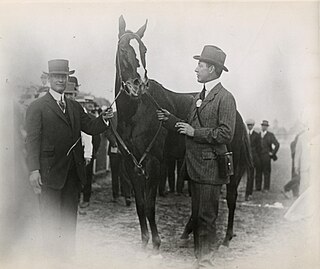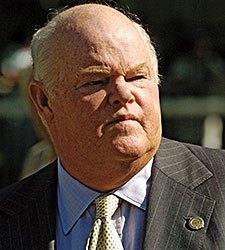Related Research Articles

The National Museum of Racing and Hall of Fame was founded in 1950 in Saratoga Springs, New York, to honor the achievements of American Thoroughbred race horses, jockeys, and trainers. In 1955, the museum moved to its current location on Union Avenue near Saratoga Race Course, at which time inductions into the hall of fame began. Each spring, following the tabulation of the final votes, the announcement of new inductees is made, usually during Kentucky Derby Week in early May. The actual inductions are held in mid-August during the Saratoga race meeting.
All Along was a champion Thoroughbred racemare that was foaled in France. She was one of the top fillies of the last part of the 20th century, racing mostly in Europe. All Along was named into the National Museum of Racing and Hall of Fame in 1990 and the Canadian Horse Racing Hall of Fame in 2019. Her only winning offspring was the Mill Reef sired colt Along All who won the Prix Greffulhe Group 2 of 1989 and was to spend his time as a sire in Japan.

James Gordon Rowe Sr. was an American jockey and horse trainer elected to the Hall of Fame for Thoroughbred Horse racing. He won the Belmont Stakes twice as a jockey and 8 times as a trainer. He had 34 champion horses to his credit, more than any other trainer in the Hall of Fame.
Sam-Son Farm is a Thoroughbred horse racing stable with farms located in Milton, Ontario (Canada) and Ocala, Florida (U.S.). Established in the 1960s by Ernest L. "Ernie" Samuel, it began as a home for competition hunter/jumper horses. One Sam-Son horse won the 1967 Pan-American Games Individual Jumping Gold Medal and was a member of the 1968 Team Gold Medal for Canada at the Mexico Olympics.
Miesque was a champion Thoroughbred racemare. At age three, she was a dual Classic winner in France and Britain, then went on to win the Breeders' Cup Mile in America. Her four-year-old campaign was highlighted by another win in the Mile, making her the first horse to win two consecutive Breeders' Cup races. She was a Group One/Grade I (G1) winner at two, three and four-years-old, for a total of 10 G1 wins. She was inducted into the American Racing Hall of Fame in 1999.
The Sovereign Award is given annually since 1975 by the Jockey Club of Canada to the outstanding horses and people in Canadian Thoroughbred racing.
Braulio Baeza is an American Thoroughbred horse racing Hall of Fame jockey and one of the master Thoroughbred jockeys of our time. In 1963, he was the first Latin American jockey to win the Kentucky Derby. Baeza began his racing career in 1955 in Panama at Hipodromo Juan Franco, and in March 1960, was invited to Miami, Florida to ride under contract for Owner/Trainer, Fred Hooper. He rode his first race in the US in the first race on Keeneland's opening day, 1960, and won it on Foolish Youth.
Christopher Chenery was an American engineer, businessman, and the owner/breeder of record for Thoroughbred horse racing's U.S. Triple Crown champion Secretariat.
Manila was an American Thoroughbred Hall of Fame Champion racehorse. He was sired by Northern Dancer's son Lyphard, out of the mare Dona Ysidra. He was bred by Filipino food and beverage magnate Eduardo Cojuangco, Jr. who owned Dona Ysidra and who named her for his grandfather's sister, Dona Ysidra Cojuangco (1867–1960) of Tarlac, reportedly the founder of the Cojuangco family fortune.

Stage Door Johnny was an American Thoroughbred racehorse best known for his win in the third leg of the 1968 U.S. Triple Crown series, the Belmont Stakes.
MacKenzie "Mack" Todd Miller was an American Thoroughbred racehorse trainer and owner/breeder. During his forty-six-year career, he conditioned seventy-two stakes winners, including four Eclipse Award champions.
Jean (John) B. LeBlanc is a Canadian retired jockey in Thoroughbred horse racing. He competed at many of the top racetracks in the United States but for most of his career was based in Ontario where he was commonly known as John, the English language translation for his name.

The Eclipse Award Trophy is presented annually to recognize those horses and individuals whose outstanding achievements have earned them the title of Champion in their respective categories. Presently there are twenty categories that include American Horse of the Year, eleven Division Champions, five connection Champions and three miscellaneous awards.
Frances A. Genter was a major figure in American Thoroughbred horse racing. She is best known as the owner of Unbridled, the 1990 American Champion Three-Year-Old Male Horse and winner of the 1990 Kentucky Derby and Breeders' Cup Classic. Part of horse racing lore took place at the 1990 Kentucky Derby when trainer Carl Nafzger called the race aloud to the petite 92-year-old Mrs. Genter because her eyesight was failing and she could not see her horse headed down the stretch en route to winning the race. The staff of Blood-Horse Publications selected the scene for its book Horse Racing's Top 100 Moments.

Ogden Mills "Dinny" Phipps was an American financier, Thoroughbred racehorse industry executive, and horse breeder. Widely known by the nickname "Dinny," he was chairman of the family's Bessemer Trust until retiring in 1994, and served as its vice chairman.
Charles LoPresti is an American race horse trainer best known as trainer of two-time Breeders' Cup Mile winner and Eclipse Award for Horse of the Year champion Wise Dan, who was also American Champion Older Male Horse and American Champion Male Turf Horse. Unusual for modern American horse trainers, he is based year-round at Keeneland Race Course and does not move his training stable from track to track throughout the year. He chooses to give his horses time off in the winter and does not race-year-round.

Irad Ortiz Jr. is a Puerto Rican jockey who has been a leading rider in the New York Thoroughbred horse racing circuit since 2012. He won his first Breeders' Cup race on Lady Eli in 2014, and his first American Classic on Creator in the 2016 Belmont Stakes. He won the 2022 Belmont Stakes on Mo Donegal.
The 2006 Breeders' Cup World Championships was the 23rd edition of the premier event of the North American thoroughbred horse racing year. It took place on November 4 at Churchill Downs in Louisville, Kentucky. The Breeders' Cup is generally regarded as the end of the North America racing season, although a few Grade I events take place in later November and December. The 2006 Breeders' Cup results were highly influential in the Eclipse Award divisional championship voting.

The 2018 Breeders' Cup World Championships was the 35th edition of the premier event of the North American thoroughbred horse racing year. The 14 races, all but one of which were Grade I, took place on November 2 and 3 at Churchill Downs in Louisville, Kentucky. The races were telecast by NBCSN on Friday and early Saturday, and by NBC later on Saturday. The Breeders' Cup is generally regarded as the end of the North American racing season, although a few Grade I events take place in later November and December. The event typically determines champions in many of the Eclipse Award divisions, although it was missing the eventual Horse of the Year, Triple Crown champion Justify, who was retired in July.
Spinaway was an American Thoroughbred filly for whom the Grade 1 Spinaway Stakes at Saratoga Race Course is named.
References
- ↑ Thoroughbred Racing Associations
- ↑ Fite, David. "Eclipse Awards". National Thoroughbred Racing Association. Retrieved September 3, 2019.
- ↑ "Eclipse Awards Presented By Record Number Of Sponsors, Partners". Paulick Report. 2019-01-16. Retrieved 2019-04-20.
- ↑ The Bloodhorse.com Champion's history charts Archived September 4, 2012, at the Wayback Machine
- ↑ "Among the initiatives and organizations supported by The Jockey Club" (PDF). The Jockey Club. 2019-01-01. Retrieved 2019-04-13.
- ↑ ESPN - August 5, 2003 Retrieved February 19, 2012
- ↑ "Among the initiatives and organizations supported by The Jockey Club" (PDF). The Jockey Club. 2019-01-01. Retrieved 2019-04-13.
- ↑ "James G. Rowe Sr". racingmuseum.org. 2019-01-01. Retrieved 2019-04-13.
- ↑ "John E. Madden". racingmuseum.org. 2019-01-01. Retrieved 2019-04-13.
- ↑ "Champions, Kentucky Derby winners" (PDF). Churchill Downs Incorporated. 2018-01-01. Retrieved 2019-04-13.
- ↑ Bowen, Edward L. (2007). Masters of the Turf: Ten Trainers Who Dominated Horse Racing's Golden Age. ISBN 978-1581501490.
- ↑ Thoroughbred Heritage
- Church, Michael (2000). Eclipse - The Horse - The Race - The Awards. Thoroughbred Advertising. p. 415. ISBN 0-9538939-0-1.